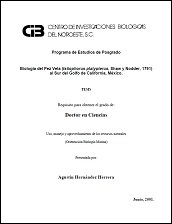Extreme genetic divergence in the endemic fish Chirostoma humboldtianum: implications for its conservation
Divergencia genética extrema en el pez endémico Chirostoma humboldtianum: implicaciones para su conservación
Autor
ROSA MARIA GARCIA MARTINEZ
HECTOR OMAR MEJIA GUERRERO
FRANCISCO JAVIER GARCIA DE LEON
IRENE DE LOS ANGELES BARRIGA SOSA
Metadatos
Mostrar el registro completo del ítemResumen
"Chirostoma humboltianum is an endemic species widely distributed in isolated basins of Central México. However, habitat alteration had reduced the range of distribution and led to the local extinction of the species in some basins. During the Miocene these basins were connected, allowing dispersal and colonization of new hydrological systems. Later on, tectonic, volcanic and climatic events of the Plio-Pleistocene promoted continuous periods of isolation and reconnection allowing the species evolve through continuous cycles of expansion and contraction of its distribution. Therefore it is expected that these events have left signals in the geographical distribution and genetic diversity and divergence of existing populations. Although the analysis of genetic diversity and genetic structure in the population becomes an important factor for the conservation of a species, few studies have been made in this taxon. In this study we used a 341pb segment of the domain I of the hypervariable region of the mitochondrial control region to analyze the genetic diversity and their distribution in 20 individuals of each one of six lakes located in central México. The values of haplotypic (0 - 0.938) and nucleotide (0 - 0.0352) diversity suggested continuous periods of expansion and population contraction related with the formation of the lakes during the Pleistocene which is supported by the BSP and mismatch analysis, and recent anthropogenic factors. In addition, the large number of exclusive haplotypes (66%) and the highly significant genetic differentiation among populations suggests that each one of the population must be conserved because each one is an important component in the evolutionary legacy of the species. " "Chirostoma humboltianum es una especie endémica ampliamente distribuida en cuencas aisladas del Centro de México. Sin embargo, la alteración del hábitat ha reducido drásticamente el área de distribución y llevado a la extinción local de la especie en algunas cuencas. Durante el Mioceno estas cuencas estuvieron conectadas, permitiendo la colonización y dispersión en nuevos sistemas hidrológicos. Posteriormente, los eventos tectónicos, volcánicos y climáticos del Plio-Pleistoceno promovieron continuos periodos de aislamiento y reconexión, permitiendo que la especie evolucionara a través de ciclos de expansión y contracción de su distribución. Por lo tanto, se espera que estos eventos hayan dejado huella en la distribución geográfica y diversidad genética de las poblaciones existentes. Si bien, el análisis de la diversidad genética en una población llega a ser un factor importante para la conservación de una especie, pocos estudios han sido realizados en este taxón. En este trabajo usamos un segmento de 341pb del dominio I hipervariable de la región control mitocondrial, para analizar la diversidad genética y su distribución para 20 individuos de cada uno de los seis lagos localizados en la región central de México. Los valores de diversidad haplotípica (0-0.938) y nucleotídica (0-0.0352) sugieren continuos periodos de expansión y contracción poblacional relacionado con la formación de los lagos en el Pleistoceno lo cual es soportado por los análisis BSP y mismatch; y de factores antropogénicos recientes. En adición, la gran cantidad de haplotipos exclusivos (66%) y la alta diferenciación genética significativa entre las poblaciones, sugiere que cada una de las poblaciones debe de ser conservada porque cada una es un componente importante en el legado evolutivo de la especie."
Colecciones
Ítems relacionados
Mostrando ítems relacionados por Título, autor o materia.
-
PROMOCIÓN DEL PERIFITON PARA EL CULTIVO DE CAMARÓN BLANCO: HACIA UNA ACUICULTURA ECOLÓGICA
DOMENICO VOLTOLINA LOBINA; JUAN MANUEL AUDELO NARANJO; MARIA DEL ROSARIO PACHECO MARGES -
Suelo y Erosión
YOLANDA LOURDES MAYA DELGADO


